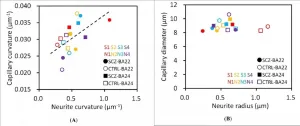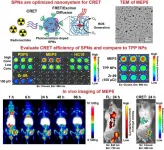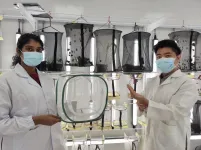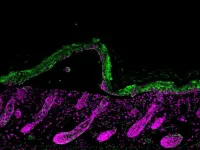Brain capillary structures show a correlation with their neuron structures
2021-06-14
(Press-News.org) Drs. Itokawa, Mizutani and colleagues performed microtomography experiments the BL20XU beamline of the SPring-8 synchrotron radiation facility and found that brain capillary structures show a correlation with their neuron structures.
Brain blood vessels constitute a micrometer-scale vascular network responsible for supply of oxygen and nutrition. In this study, we analyzed cerebral tissues of the anterior cingulate cortex and superior temporal gyrus of schizophrenia cases and age/gender-matched controls by using synchrotron radiation microtomography or micro-CT in order to examine the three-dimensional structure of cerebral vessels.
All post-mortem human cerebral tissues were collected with informed consent from the legal next of kin using protocols approved by the Clinical Study Reviewing Board of Tokai University School of Medicine (application no. 07R-018) and the Ethics Committee of Tokyo Metropolitan Institute of Medical Science (approval no. 17-18). This study was conducted according to the Declaration of Helsinki under the approval of the Ethics Committee for the Human Subject Study of Tokai University (approval nos. 11060, 11114, 12114, 13105, 14128, 15129, 16157, 18012, 19001, 20021, and 20022). The schizophrenia patients S1-S4 and control cases N1-N4 of this study are the same as those analyzed in our previous report on neuron structure. Cerebral tissues of Brodmann area 22 (BA22) of the superior temporal gyrus and BA24 of the anterior cingulate cortex were collected from the left hemispheres of the post-mortem brains and subjected to Golgi impregnation. The Golgi-stained tissues were then embedded in borosilicate glass capillaries using epoxy resin.
Three-dimensional structures of blood vessel networks in the brain tissues of BA22 of the superior temporal gyrus and BA24 of the anterior cingulate cortex were visualized by using synchrotron radiation microtomography or micro-CT. Over 1 m of cerebral blood vessels was traced to build Cartesian-coordinate models, which were then used for calculating structural parameters including the diameter and curvature of the vessels.
The curvature plot illustrates a significant correlation of the mean curvature of capillary vessels to that of neurites (Spearman's ρ = 0.63, p = 0.011, n = 16), indicating that the brain tissues with tortuous neuronal networks have tortuous capillary vessels. No significant difference in the slope was observed between the schizophrenia and control groups. The mean capillary curvature showed a difference in its variance between brain areas. The capillary curvatures of BA22 were widely distributed, while those of BA24 were limited to a confined range (Fig. A), resulting in a significant difference in variance (p = 0.019, Bartlett's test, n = 8). We also examined the relation between the capillary diameter and neurite thickness radius (Fig. B). In contrast to the curvature correlation, the mean capillary diameter showed no correlation with the neurite thickness radius, but was rather constant regardless of neurite thickness. This result indicates that the capillary vessel size is determined independently of the neuron structure.
Our previous studies indicated that the neurites of schizophrenia cases are thin and tortuous compared to controls. The curved capillaries with a constant diameter should occupy a nearly constant volume, while neurons suffering from neurite thinning should have reduced volumes, resulting in a volumetric imbalance between the neurons and the vessels. We suggest that the observed structural correlation between neurons and blood vessels is related to neurovascular abnormalities in schizophrenia.
Kraepelin placed schizophrenia in a chapter on metabolic disorders in the fifth edition of his Psychiatrie published in 1896. He predicted metabolic disfunction and neuropathological change as the basis of schizophrenia. we can regard the above-mentioned results as the first example suggesting metabolic abnormality due to capillary and neuron imbalance.
INFORMATION:
[Attachments] See images for this press release:

ELSE PRESS RELEASES FROM THIS DATE:
2021-06-14
A new species of large prehistoric croc that roamed south-east Queensland's waterways millions of years ago has been documented by University of Queensland researchers.
PhD candidate Jorgo Ristevski, from UQ's School of Biological Sciences, led the team that named the species Gunggamarandu maunala after analysing a partial skull unearthed in the Darling Downs in the nineteenth century.
"This is one of the largest crocs to have ever inhabited Australia," Mr Ristevski said.
"At the moment it's difficult to estimate the exact overall size of Gunggamarandu since all we have is the back of the skull - but it was big.
"We estimate the skull would have been at least 80 centimetres long, and based on comparisons with living crocs, this indicates a total ...
2021-06-14
Summer picnics and barbecues are only a few weeks away! As excited as you are to indulge this summer, Escherichia coli bacteria are eager to feast on the all-you-can-eat buffet they are about to experience in your gut.
However, something unexpected will occur as E. coli cells end their journey through your digestive tract. Without warning, they will find themselves swimming in your toilet bowl, clinging to the last bits of nutrients attached to their bodies. How do these tiny organisms adapt to survive sudden starvation? Scientists at Washington University in St. Louis wondered.
Close examination of nutrient-deprived E. coli ...
2021-06-14
Reston, VA (Embargoed until 12:30 p.m. EDT, Monday, June 14, 2021) - Researchers have successfully developed a novel cancer treatment approach that utilizes Cerenkov radiation energy to target and destroy cancer cells more effectively. The approach uses light from decaying radiopharmaceuticals, known as Cerenkov luminescence, as an energy source to activate semiconducting polymer nanoparticles that kill cancer cells. This research was presented at the Society of Nuclear Medicine and Molecular Imaging's 2021 Virtual Annual Meeting.
Over the past several decades, many studies have been conducted on photodynamic therapy, ...
2021-06-14
Alzheimer's disease is the most common form of dementia and is characterized by neurodegeneration in regions of the brain involved in memory and learning. Amyloid beta and tau are two toxic proteins that build up in disease and cause eventual neuronal death, but little is known about how other cells in the brain react during disease progression.
A new study from the ASU-Banner Neurodegenerative Research Center (NDRC) and MIT/Koch Institute sheds new light on how disease processes manifest in patients with Alzheimer's disease.
Diego Mastroeni of the NDRC teamed up Forest White and Douglas Lauffenburger, colleagues in MIT's Department of Biological Engineering, to explore how protein ...
2021-06-14
Osaka, Japan - Researchers from the Graduate School of Engineering and the Center for Quantum Information and Quantum Biology at Osaka University unveiled a new solid state second-harmonic generation (SHG) device that converts infrared radiation into blue light. This work may lead to a practical daily-use deep ultraviolet light source for sterilization and disinfection.
Recently, deep ultraviolet (DUV) light sources have been attracting much attention in sterilization and disinfection. In order to realize a bactericidal effect while ensuring user safety, a wavelength range of 220-230 nm is desirable. ...
2021-06-14
Singapore, 14 June 2021 - Many butterfly species bear distinct circular markings known as eyespots on their wings, and the functions of these rings of contrasting colours vary. A long-standing theory is that they serve as anti-predator defences - small eyespots along the wing margin can protect butterflies by directing predators to attack less important parts of the body, such as the hindwings, enabling them to escape.
Most nymphalid family butterflies have half as many eyespots on their forewings compared to their hindwings. In particular, this has been observed in the bush brown butterfly Bicyclus anynana.
A recent research by biologists from the National University of Singapore (NUS) sought to understand the impact of uneven distribution of eyespots. ...
2021-06-14
A team of scientists has shown that the healing of skin blisters is driven by hair follicle stem cells, which delay their own development in the process.
The healing process of the tissues in the human body is particularly well-studied in skin, especially as skin serves as a layer of protection from the environment. However, there remain some specific types of skin injuries where the healing process is not well understood.
A team of scientists from Japan and Italy, including Associate Professor Ken Natsuga from the Graduate School of Medicine at Hokkaido University, have used models of skin blisters to explore the effects of injury on developing skin tissue. Their discoveries ...
2021-06-14
Nearly 12,000 people in Sweden received sickness benefit from the Swedish Social Insurance Agency for COVID-19 during the first wave of the pandemic. The median duration of sick leave in this group was 35 days, but for many it was considerably more long-drawn-out, according to a University of Gothenburg study.
A research group in rehabilitation medicine at the University of Gothenburg has studied sick-leave patterns. The study now presented in the scientific journal BMC Public Health.
The study included all recipients of sickness benefit from the Social Insurance Agency for COVID-19 diagnoses in Sweden during the first pandemic wave, from 1 March to 31 August 2020, and monitored them for 4 months from the start of ...
2021-06-14
Artemisone is a promising substance in the fight against malaria. However, the active ingredient has yet to be used due its instability and because it is not easily absorbed by the body. A team from Martin Luther University Halle-Wittenberg (MLU) and the Hebrew University of Jerusalem has now pushed this a bit further. They have developed a very simple method for preparing the active ingredient that makes it easier to administer and store. The researchers report on their work in the scientific journal "Antimicrobial Agents and Chemotherapy".
Malaria is caused ...
2021-06-14
High running capacity is associated with health and longevity. However, whether high genetic running capacity promotes more efficient metabolism with aging is not known. A new study conducted in collaboration between the universities of Shanghai Jiao Tong University (China) and Jyväskylä (Finland) investigated the effects of genetic running capacity and aging on tissue metabolism. The study reveals that adipose tissue may have a key role in healthy aging.
Running capacity, expressed as aerobic capacity, refers to an individual's capacity to utilize oxygen and is known to decrease with age, thereby affecting the whole body metabolism and health.
"We currently lack the information ...
LAST 30 PRESS RELEASES:
[Press-News.org] Brain capillary structures show a correlation with their neuron structures








